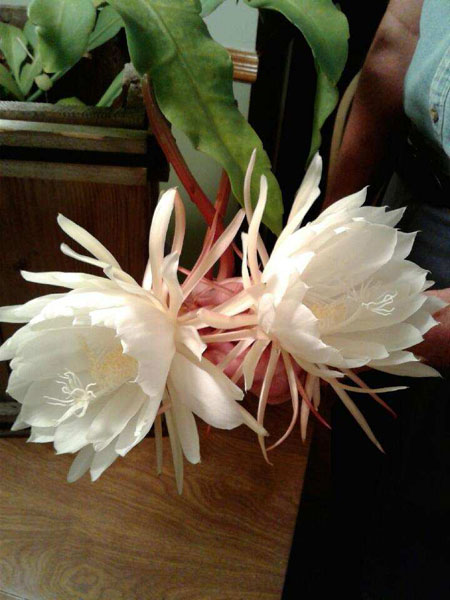
FOR IMMEDIATE RELEASE: October 10, 2019
MEDIA CONTACTS: Carole Trottere, Rebecca Cheng and Matthew Leonenko | (516) 869-7794
Cereus Cactus Bloom at Clark Botanic Garden Appears ‘One Night Only’
Town Staff Kept Eye on Exotic Night Blooming Cactus Flower
North Hempstead, NY –North Hempstead’s Clark Botanic Garden is home to an exotic cactus that blooms just once a year for a few hours! Town staff took turns “plant-sitting” over last weekend waiting for the Cereus cactus to bloom. It finally opened its white exquisitely scented flowers on Monday, October 1 between 9 p.m. until dawn. The plant has been tenderly cared for at Clark Botanic Garden by Jim Newman, staff horticulturist of the Fanny Dwight Memorial Garden, Inc., the non-profit arm of the Garden.
“The cereus cactus is a fleeting, but spectacular thing to see,” said North Hempstead Town Supervisor Judi Bosworth. “I commend the Town’s staff who worked as a team to make sure we captured the moment in pictures!”
Town Horticulturist Bonne Klein sent the call out last week for a plant sitter who could take the plant home and take some photos when it bloomed. But after two days in the care of Town Photographer Russell Lippai…nothing. Upon its return to the Clark Botanic Greenhouse however, it was Mr. Newman’s turn to take it home.
“It bloomed that night at 9 p.m. and was wilting by daylight,” he said.
Clark Botanic Garden in Albertson, is a 12-acre public garden currently maintained and operated by the Parks & Recreation Department of the Town of North Hempstead with the support of the Fanny Dwight Clark Memorial Garden Corporation, a non-profit. The Garden consists of 3 ponds connected by streams beds feed by a natural well, a formal rose garden, a pine stand, a family community garden, a holly maze, an apiary, woodland area, and many collections of specimen plants and trees. Botanic gardens were founded to help foster the understanding of plants and the important role they play in our world. The early botanic gardens were established for research of medicinal plant properties. The popularity and curiosity of botany, at that time, evolved botanic gardens into educational cultural institutions displaying collections and continued research of plants. The main focus of this research was for ecological conservation. Showcasing sustainable methods at a public botanic garden conveys the significance of ecological conservation through displays and education.
